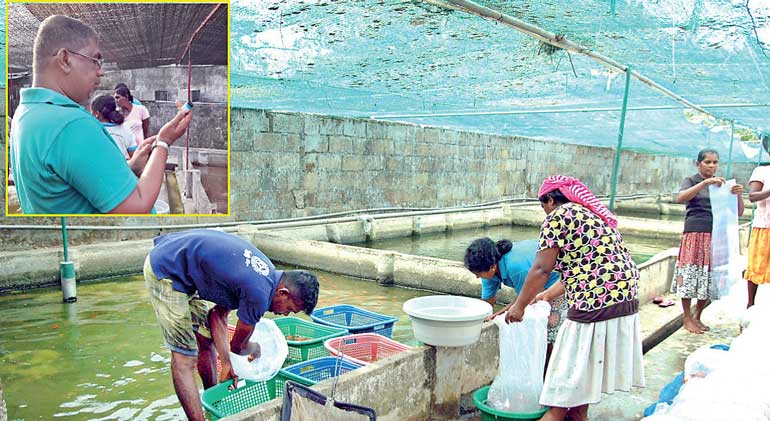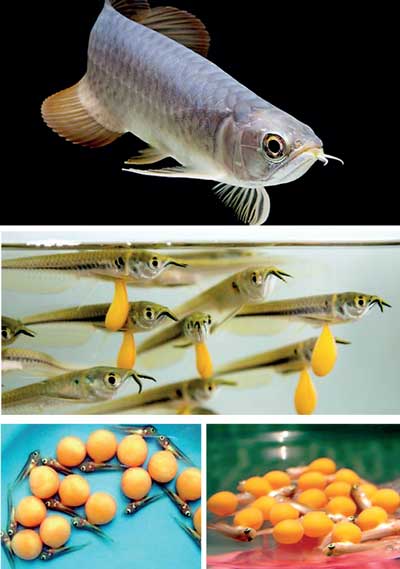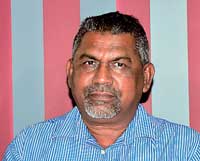Monday Jan 05, 2026
Monday Jan 05, 2026
Tuesday, 12 December 2017 00:00 - - {{hitsCtrl.values.hits}}

For the first time in Sri Lanka, successful captive breeding of Asian arowana (Scleropages formosus) has been recorded in the Polonnaruwa district recently. The species is considered as a high valued ornamental fish in the international market and the local market as well. This fish is generally called as ‘Lucky Fish’ in Sri Lanka and famous as Dragon Fish in Chinese culture as it resemblance the Chinese Dragon, an auspicious symbol. At present Arowana is among the top imported live fish species in to Sri Lanka to fulfil the growing local demand from aquarium hobbyists. 
The value of an arowana fish in the local market varies from Rs. 5,000 to 500,000 based on the size colour and the other body features. Therefore the commercial expansion of arowana production will be a turning point for the ornamental fish industry in Sri Lanka while it will substitute the imports
International trade of arowana is controlled under the Convention on the International Trade in Endangered Species of Wild Flora Fauna (CITES). However CITES allows Asian arowana to be traded when they are bred in captivity with proven records.
Breeding of arowana is not an easy task; it requires a lot of ground facilities like larger size earthen ponds, good brood stock and a breeder with good skill of breeding. It takes approximately 3-4 years to prepare a broodstock for breeding. D.M. Wimalsiri, the owner of the OASIS Fish Farm at Polonnaruwa and the Managing Director of Shine Aqua International Trading Ltd. has fulfilled all above requirements patiently and is the one who achieved this difficult task of breeding of arowana for the first time in Sri Lanka with his long term efforts and professional fish breeding skills. 
EDB has identified D.M. Wimalsiri as a professional fish breeder and a good entrepreneur during the period EDB implemented a project in the Polonnaruwa district to increase the export supply base and the quality of fish during the period 2008-2012. At that time he was the President of the Ornamental Fish Growers Association established by the EDB in the Polonnaruwa district. Having identified the potential for ornamental fish farming for export in the Polonnaruwa district, EDB with the support of other relevant government agencies implemented the above project in order to increase the supply base for export and to improve the quality of fish produced from Polonnaruwa. He was among one of the 225 beneficiaries under the project which had a significant impact on the lives of people in the Polonnaruwa district, where it has eventually became the supply hub for ornamental fish exports from Sri Lanka at present. Wimalsiri is the top supplier of fish for export from Polonnaruwa at present, having a number of ponds in an area of 28 acres of land. He has the biggest out grower network in the industry of more than 525 small scale well established suppliers connected with him, which provides a livelihood for more than 1,000 farmers in the area in addition to the 50 direct employments given by him in his three farms located in the Polonnaruwa district.
He has been further assisted by the EDB by providing a grant worth of Rs. 1.5 million to set up a quarantine facility under the fish quality improvement project implemented by the EDB during the period of 2012-2015. With all these supports given by the government and with his own effort, he is now ready to explore the international market where EDB is continuously supporting him up by giving required assistance.
Wimalsiri is grateful for all the support given by the EDB especially the international exposure given by facilitating him to attend ‘Aqurama’ 2013 and 2015 Exhibitions in Singapore where he won an award at the international fish competition held during the Aquarama exhibition. He was also able to visit the Arowana breeding farms during the Farm Visit Program organised by the EDB. According to him that’s how he motivated and got the idea of having his own arowana farm in Sri Lanka.